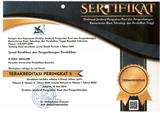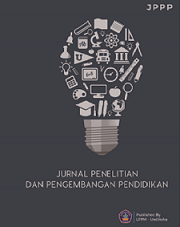Thematic Teaching Materials Using Science, Technology, Engineering and Mathematics Approaches to Improve Problems Solving Ability of Elementary School Students
DOI:
https://doi.org/10.23887/jppp.v7i1.60361Keywords:
Teaching Materials, STEM Approach, Problem Solving AbilityAbstract
Thematic learning is expected that learning activities can involve students actively and in learning activities, so that students get direct experience which makes learning activities much more meaningful. Thematic teaching materials with the STEM approach are an alternative to improve students' problem-solving abilities. This study aims to analyze the validity, convenience, attractiveness, usefulness, and effectiveness of thematic teaching materials with the STEM approach to improve students' problem solving abilities in elementary schools. This research is a type of Research and Development (R&D) research, the development is carried out according to the theory of Borg & Gall. The subjects in this study were determined using a purposive sampling technique and obtained as many as 20 students. The data collection tool uses valid and reliable test instruments. Validity data analysis techniques show that thematic teaching materials with the STEM approach are very valid to use. Effectiveness data analysis technique uses N-Gain with a calculation result of 0.57 with a significance of 0.01<0.05. Based on this research, it can be concluded that the thematic teaching materials with the STEM approach developed are valid and effective for improving students' problem solving abilities in elementary schools.
References
Ana, M., & Ndole, T. (2021). Efektivitas Penilaian Pembelajaran Matematika Selama Masa Pandemi Covid-19 SDK Ndona 2 Kecamatan Ndona Kabupaten Ende. Jupika: Jurnal Pendidikan Matematika, 4(1), 82–91. https://doi.org/10.37478/jupika.v4i1.903. DOI: https://doi.org/10.37478/jupika.v4i1.903
Andini, S., Budiyono, & Fitriana, L. (2018). Developing flipbook multimedia: The achievement of informal deductive thinking level. Journal on Mathematics Education, 9(2), 227–238. https://doi.org/10.22342/jme.9.2.5396.227-238. DOI: https://doi.org/10.22342/jme.9.2.5396.227-238
Antara, I. G. W. S., Sudarma, I. K., & Dibia, I. K. (2020). The Assessment Instrument of Mathematics Learning Outcomes Based on HOTS Toward Two-Dimensional Geometry Topic. Indonesian Journal Of Educational Research and Review, 3(2), 19–24. https://doi.org/10.23887/ijerr.v3i2.25869. DOI: https://doi.org/10.23887/ijerr.v3i2.25869
Aristianti, E., Susanto, H., & Marwoto, P. (2018). Implementasi Model Pembelajaran Inkuiri Terbimbing Terhadap Kemampuan Pemecahan Masalah dan Komunikasi Ilmiah Siswa SMA. Jurnal Pendidikan Fisika UNNES, 7(1), 67–73. https://journal.unnes.ac.id/sju/index.php/upej/article/view/22470.
Arum, T. S., & Wahyudi, W. (2016). Pengembangan Modul Pembelajaran Tematik Integratif Subtema Hubungan Makhluk Hidup Dalam Ekosistem Pendekatan Saintifik Untuk Kelas 5 Sd. Scholaria : Jurnal Pendidikan Dan Kebudayaan, 6(3), 239. https://doi.org/10.24246/j.scholaria.2016.v6.i3.p239-250. DOI: https://doi.org/10.24246/j.scholaria.2016.v6.i3.p239-250
Astutiani, R., Isnarto., & Isti. (2019). Pemecah Masalah Matematika dalam Menyelesaikan Soal Cerita Berdasarkan Langkah Polya. Jurnal Pendidikan Matematika UNNES, 10(2), 297–303.
Bashooir, K., & Supahar. (2018). Validitas dan Reabilitas Instrumen Asesmen Kinerja Literasi Sains Pelajaran Fisika Berbasis STEM. Jurnal Penelitian Dan Evaluasi Pendidikan, 22(2), 219–230. https://doi.org/10.21831/pep.v22i2.19590. DOI: https://doi.org/10.21831/pep.v22i2.19590
Bi, H., Mi, S., Lu, S., & Hu, X. (2020). Meta-analysis of interventions and their effectiveness in students’ scientific creativity. Thinking Skills and Creativity, 38, 100750. https://doi.org/10.1016/j.tsc.2020.100750. DOI: https://doi.org/10.1016/j.tsc.2020.100750
Chonkaew, P., Sukhummek, B., & Faikhamta, C. (2019). STEM Activities in Determining Stoichiometric Mole Ratios for Secondary- School Chemistry Teaching. Journal of Chemical Education, 96(6), 1182–1186. https://doi.org/10.1021/acs.jchemed.8b00985. DOI: https://doi.org/10.1021/acs.jchemed.8b00985
Damayanti, H. T., & Sumardi, S. (2018). Mathematical creative thinking ability of junior high school students in solving open-ended problem. JRAMathEdu (Journal of Research and Advances in Mathematics Education), 3(1), 36–45. https://doi.org/10.23917/jramathedu.v3i1.5869. DOI: https://doi.org/10.23917/jramathedu.v3i1.5869
Dharmayanti, L., Munandar, I. A., & Mugara, R. (2019). Penerapan Pendekatan Pembelajaran Kontekstual Untuk Meningkatkan Pemahaman Konsep Matematika Pada Siswa Sekolah Dasar Kelas IV. Journal of Elementary Education, 02(06), 240–244. https://journal.ikipsiliwangi.ac.id/index.php/collase/article/download/3566/1237.
Effendi, R., Herpratiwi, H., & Sutiarso, S. (2021). Pengembangan LKPD Matematika Berbasis Problem Based Learning di Sekolah Dasar. Jurnal Basicedu, 5(2), 920–929. https://doi.org/10.31004/basicedu.v5i2.846. DOI: https://doi.org/10.31004/basicedu.v5i2.846
Epita, R. Y., Ruslan, D., & Sumarno. (2021). Development of Contextual-Based Thematic Teaching Materials to Improve Learning Outcomes of Class V Students of Pilot Public Elementary School in Kabanjahe. International Journal of Multi Science, 1(10), 96–102. https://www.multisciencejournal.com/index.php/ijm/article/view/140.
Farhurohman, O. (2017). Implementasi Pembelajaran Bahasa Indonesia di SD/MI. Primary: Jurnal Keilmuan Dan Kependidikan Dasar, 9(1), 23–34. http://jurnal.uinbanten.ac.id/index.php/primary/article/view/412.
Fitriatien, L., IP, & Prayogo. (2021). Pengaruh Model Pembelajaran Connected Mathematics Project (CMP) Terhadap Kemampuan Pemecahan Masalah Matematis Siswa SMP. Proximal: Jurnal Penelitian Matematika Dan Pendidikan Matematika, 4(2), 48–55. https://doi.org/10.30605/proximal.v4i2.1243. DOI: https://doi.org/10.30605/proximal.v4i2.1243
Gog, T. van, Hoogerheide, V., & Harsel, M. van. (2020). The Role of Mental Effort in Fostering Self-Regulated Learning with Problem-Solving Tasks. Educational Psychology Review, 32(4), 1055–1072. https://doi.org/10.1007/s10648-020-09544-y. DOI: https://doi.org/10.1007/s10648-020-09544-y
Han, S., Rosli, R., Capraro, M. M., & Capraro, R. M. (2016). The effect of Science, technology, engineering and mathematics (STEM) project based learning (PBL) on students’ Achievement in four mathematics topics. Journal of Turkish Science Education, 13(Specialissue), 3–30. https://doi.org/10.12973/tused.10168a.
Hermawan, I. (2019). Metodologi Penelitian Pendidikan (Kualitatif, Kuantitatif dan Mixed Method). Hidayatul Quran.
Hidayat, W., & Sariningsinh, R. (2018). Kemampuan Pemecahan Masalah Matematis Dan Adversity Quotient Siswa SMP Melalui Pembelajaran Open Ended. Jurnal JNPM (Jurnal Nasional Pendidikan Matematika), 2(1), 109–118. https://doi.org/10.33603/jnpm.v2i1.1027. DOI: https://doi.org/10.33603/jnpm.v2i1.1027
Hidayati, A. U. (2017). Melatih keterampilan berpikir tingkat tinggi dalam pembelajaran matematika pada siswa sekolah dasar. Terampil: Jurnal Pendidikan Dan Pembelajaran Dasar, 4(2), 143–156. https://doi.org/10.24042/terampil.v4i2.2222.
Isatunada, U., & Haryani, S. (2021). Development of science learning tools using the STEM approach to train problem solving ability and students activeness in global warming material. Jurnal Pendidikan Sains Indonesia, 9(3), 363–375. https://doi.org/10.24815/jpsi.v9i3.19599. DOI: https://doi.org/10.24815/jpsi.v9i3.19599
Jannah, K., & Pahlevi, T. (2020). Pengembangan Instrumen Penilaian Berbasis Higher Order Thinking Skills Berbantuan Aplikasi" Kahoot!" Pada Kompetensi Dasar Menerapkan Penanganan Surat Masuk Dan Surat Keluar Jurusan OTKP Di SMK Negeri 2 Buduran. Jurnal Pendidikan Administrasi Perkantoran (JPAP), 8(1), 108–121. https://doi.org/10.26740/jpap.v8n1.p108-121. DOI: https://doi.org/10.26740/jpap.v8n1.p108-121
Jehadus, E., Tamur, M., Murni, V., Nendi, F., & Ndiung, S. (2021). The Influence of Open-Ended Approach with Group-To-Group Strategy on the Improvement of Mathematic Communication Skills for High School Students. Proceedings of the 1st International Conference on Education, Humanities, Health and Agriculture (ICEHHA) 2021, 1(1). https://doi.org/10.4108/eai.3-6-2021.2310737. DOI: https://doi.org/10.4108/eai.3-6-2021.2310737
Khikmiyah, F. (2021). Implementasi Web Live Worksheet Berbasis Problem Based Learning Dalam Pembelajaran Matematika. Pedagogy: Jurnal Pendidikan Matematika, 6(1), 1–12. https://doi.org/10.30605/pedagogy.v6i1.1193. DOI: https://doi.org/10.30605/pedagogy.v6i1.1193
Lestari, D. A. B., Astuti, B., & Darsono, T. (2018). Implementasi LKS Dengan Pendekatan STEM (Science, Technology, Engineering, And Mathematics) Untuk Meningkatkan Kemampuan Berpikir Kritis Siswa. Jurnal Pendidikan Fisika Dan Teknologi, 4(2), 202–207. https://doi.org/10.29303/jpft.v4i2.809. DOI: https://doi.org/10.29303/jpft.v4i2.809
Lestariningsih, N., & Suardiman, S. P. (2017). Pengembangan Bahan Ajar Tematik-Integratif Berbasis Kearifan Lokal Untuk Meningkatkan Karakter Peduli Dan Tanggung Jawab. Jurnal Pendidikan Karakter, 7(1). https://doi.org/10.21831/jpk.v7i1.15503. DOI: https://doi.org/10.21831/jpk.v0i1.10737
Lumbantobing, S. S., & Azzahra, S. F. (2020). Meningkatkan Kemampuan Berpikir Kreatif Siswa dalam Menghadapi Revolusi Industri 4.0 Melalui Penerapan Pendekatan STEAM ( Science, Technology, Engineering. Arts and Mathematics). Jurnal Dinamika Pendidikan, 13(3), 393–400. http://repository.uki.ac.id/3358/.
Mahmud, M. R., & Pratiwi, I. M. (2019). Literasi Numerasi Siswa Dalam Pemecahan Masalah Tidak Terstruktur. KALAMATIKA Jurnal Pendidikan Matematika, 4(1), 69–88. https://doi.org/10.22236/kalamatika.vol4no1.2019pp69-88. DOI: https://doi.org/10.22236/KALAMATIKA.vol4no1.2019pp69-88
Masykur, R. (2017). Pengembangan bahan ajar tematik dalam implementasi kurikulum 2013 kelas 1 sekolah dasar. EduHumaniora| Jurnal Pendidikan Dasar Kampus Cibiru, 9(2), 93–98. https://doi.org/10.17509/eh.v9i2.7039. DOI: https://doi.org/10.17509/eh.v9i2.7039
Nathan, M. (2014). Integrasi dalam Pendidikan STEM K–12: Status, Prospek, dan Agenda Penelitian. Konferensi & Eksposisi Tahunan ASEE, 121(2), 28–35.
Ningrum, D. S., & Leonard, L. (2015). Pengembangan Desain Pembelajaran Matematika Sekolah Dasar Kelas 1. Formatif: Jurnal Ilmiah Pendidikan MIPA, 4(3), 163–173. https://doi.org/10.30998/formatif.v4i3.151. DOI: https://doi.org/10.30998/formatif.v4i3.151
Oktaviani, A., Anom, K., & Lesmini, B. (2020). Pengembangan Modul Kimia terintegrasi STEM (Science, Technology, Engineering and Mathematics) dan PBL (Problem-Based Learning). Journal of Educational Chemistry (JEC), 2(2), 64. https://doi.org/10.21580/jec.2020.2.2.6279. DOI: https://doi.org/10.21580/jec.2020.2.2.6279
Pardede, P. (2020). Integrating the 4Cs into EFL Integrated Skills Learning. Journal of English Teaching, 6(March), 71–85. https://doi.org/10.33541/jet.v6i1.190. DOI: https://doi.org/10.33541/jet.v6i1.190
Parmiti, D. P., Antara, I. G. W. S., & Wulandari, I. G. A. A. M. (2022). The Effectiveness of E-Scrapbook Media Containing HOTS Questions on Science Learning Outcomes of Elementary School Students. Journal of Education Research and Evaluation, 6(3), 484–491. https://doi.org/10.23887/jere.v6i3.52078. DOI: https://doi.org/10.23887/jere.v6i3.52078
Puspitasari, R. D., Herlina, K., & Suyatna, A. (2020). A Need Analysis of STEM-Integrated Flipped Classroom E-Module to improve Critical Thinking Skills. Indonesian Journal of Mathematics Education, 3(2), 178–184. https://doi.org/10.24042/ijsme.v3i2.6121. DOI: https://doi.org/10.24042/ijsme.v3i2.6121
Rabbani, S., & Muftianti, A. (2020). Implementasi Bahan Ajar Menggunakan Pendekatan Pendidikan Matematika Realistik Pada Komunikasi Matematika Siswa Sekolah Dasar. Jurnal Pendidikan Dasar, 4(2), 230–240. DOI: https://doi.org/10.24036/jippsd.v4i2.105065
Rahayu, D. V, & Afriansyah, E. A. (2015). Meningkatkan Kemampuan Pemecahan Masalah Matematik Siswa Melalui Model Pembelajaran Pelangi Matematika. Mosharafa: Jurnal Pendidikan Matematika, 4(1), 29–37. https://journal.institutpendidikan.ac.id/index.php/mosharafa/article/view/mv4n1_4
Rohmanurmeta, F. M., & Dewi, C. (2019). Pengembangan Komik Digital Pelestarian Lingkungan Berbasis Nilai Karakter Religi Untuk Pembelajaran Tematik Pada Siswa Sekolah Dasar. Muaddib : Studi Kependidikan Dan Keislaman, 1(2). https://doi.org/10.24269/muaddib.v1i2.1213. DOI: https://doi.org/10.24269/muaddib.v1i2.1213
Salamah, U. (2017). Model pembelajaran tematik pendidikan agama Islam di sekolah dasar. Jurnal Pendidikan Agama Islam, 11(1), 119–132. https://doi.org/10.14421/jpai.2014.111-08. DOI: https://doi.org/10.14421/jpai.2014.111-08
Sari, P. (2017). Pemahaman Konsep Matematika Siswa pada Materi Besar Sudut Melalui Pendekatan PMRI. Jurnal Gantang, 2(1), 41–50. https://doi.org/10.31629/jg.v2i1.60. DOI: https://doi.org/10.31629/jg.v2i1.60
Sari, P. K., & Sutihat, S. (2022). Pengembangan E-Modul Berbasis STEAM untuk Meningkatkan Kemampuan Berpikir Tingkat Tinggi Pada Pembelajaran Tematik di Sekolah Dasar. Jurnal Pendidikan Sains Indonesia (Indonesian Journal of Science Education), 10(3), 509–526. https://doi.org/10.24815/jpsi.v10i3.24789. DOI: https://doi.org/10.24815/jpsi.v10i3.24789
Sumartini, T. S. (2016). Peningkatan kemampuan pemecahan masalah matematis siswa melalui pembelajaran berbasis masalah. Mosharafa: Jurnal Pendidikan Matematika, 5(2), 148–158. https://doi.org/10.31980/mosharafa.v5i2.270. DOI: https://doi.org/10.31980/mosharafa.v5i2.270
Susanti, E., & Kurniawan, H. (2020). Design pembelajaran matematika dengan pendekatan STEM (science, technology, engineering, mathematics). AKSIOMA: Jurnal Matematika Dan Pendidikan Matematika, 11(1), 37–52. https://doi.org/10.26877/aks.v11i1.5292. DOI: https://doi.org/10.26877/aks.v11i1.5292
Thuneberg, H. M., Salmi, H. S., & Bogner, F. X. (2018). How creativity, autonomy and visual reasoning contribute to cognitive learning in a STEAM hands-on inquiry-based math module. Thinking Skills and Creativity, 7(3), 153–161. https://doi.org/10.1016/j.tsc.2018.07.003. DOI: https://doi.org/10.1016/j.tsc.2018.07.003
Wahyuni, L. G. E., & Pratiwi, N. P. A. (2017). Keautentikan Asesmen Guru dalam Konteks K13. Seminar Nasional Riset Inovatif 2017, 658–665.
Wakabayashi, Y., & Ishikawa, T. (2011). Spatial thinking in geographic information science: A review of past studies and prospects for the future. Procedia - Social and Behavioral Sciences, 21(November), 304–313. https://doi.org/10.1016/j.sbspro.2011.07.031. DOI: https://doi.org/10.1016/j.sbspro.2011.07.031
Yalcin, V., & Erden, S. (2021). The Effect of STEM Activities Arranged According to the Design Thinking Model on the Creativity and Problem Solving Skills of Preschool Children. Thinking Skills and Creativity, 41, 1–12. https://doi.org/10.1016/j.tsc.2021.100864. DOI: https://doi.org/10.1016/j.tsc.2021.100864
Downloads
Published
How to Cite
Issue
Section
License
Copyright (c) 2023 Titin Lestari Titin, Nurhanurawati, Caswita, Dwi Yulianti

This work is licensed under a Creative Commons Attribution-ShareAlike 4.0 International License.
Authors who publish with the Jurnal Penelitian dan Pengembangan Pendidikan agree to the following terms:
- Authors retain copyright and grant the journal the right of first publication with the work simultaneously licensed under a Creative Commons Attribution License (CC BY-SA 4.0) that allows others to share the work with an acknowledgment of the work's authorship and initial publication in this journal.
- Authors are able to enter into separate, additional contractual arrangements for the non-exclusive distribution of the journal's published version of the work (e.g., post it to an institutional repository or publish it in a book), with an acknowledgment of its initial publication in this journal.
- Authors are permitted and encouraged to post their work online (e.g., in institutional repositories or on their website) prior to and during the submission process, as it can lead to productive exchanges, as well as earlier and greater citation of published work. (See The Effect of Open Access)







